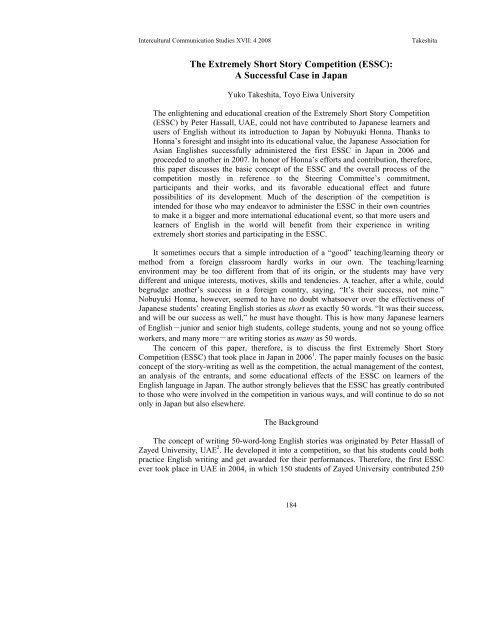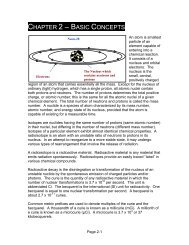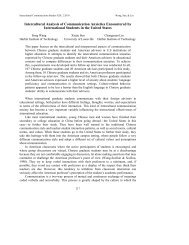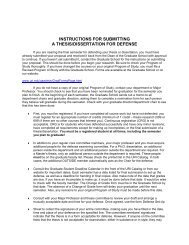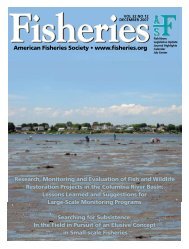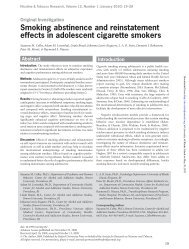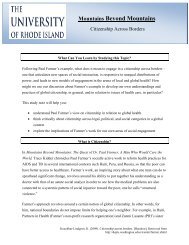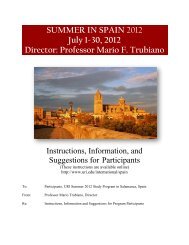The Extremely Short Story Competition (ESSC): A Successful Case ...
The Extremely Short Story Competition (ESSC): A Successful Case ...
The Extremely Short Story Competition (ESSC): A Successful Case ...
You also want an ePaper? Increase the reach of your titles
YUMPU automatically turns print PDFs into web optimized ePapers that Google loves.
Intercultural Communication Studies XVII: 4 2008 Takeshita<br />
<strong>The</strong> <strong>Extremely</strong> <strong>Short</strong> <strong>Story</strong> <strong>Competition</strong> (<strong>ESSC</strong>):<br />
A <strong>Successful</strong> <strong>Case</strong> in Japan<br />
Yuko Takeshita, Toyo Eiwa University<br />
<strong>The</strong> enlightening and educational creation of the <strong>Extremely</strong> <strong>Short</strong> <strong>Story</strong> <strong>Competition</strong><br />
(<strong>ESSC</strong>) by Peter Hassall, UAE, could not have contributed to Japanese learners and<br />
users of English without its introduction to Japan by Nobuyuki Honna. Thanks to<br />
Honna’s foresight and insight into its educational value, the Japanese Association for<br />
Asian Englishes successfully administered the first <strong>ESSC</strong> in Japan in 2006 and<br />
proceeded to another in 2007. In honor of Honna’s efforts and contribution, therefore,<br />
this paper discusses the basic concept of the <strong>ESSC</strong> and the overall process of the<br />
competition mostly in reference to the Steering Committee’s commitment,<br />
participants and their works, and its favorable educational effect and future<br />
possibilities of its development. Much of the description of the competition is<br />
intended for those who may endeavor to administer the <strong>ESSC</strong> in their own countries<br />
to make it a bigger and more international educational event, so that more users and<br />
learners of English in the world will benefit from their experience in writing<br />
extremely short stories and participating in the <strong>ESSC</strong>.<br />
It sometimes occurs that a simple introduction of a “good” teaching/learning theory or<br />
method from a foreign classroom hardly works in our own. <strong>The</strong> teaching/learning<br />
environment may be too different from that of its origin, or the students may have very<br />
different and unique interests, motives, skills and tendencies. A teacher, after a while, could<br />
begrudge another’s success in a foreign country, saying, “It’s their success, not mine.”<br />
Nobuyuki Honna, however, seemed to have no doubt whatsoever over the effectiveness of<br />
Japanese students’ creating English stories as short as exactly 50 words. “It was their success,<br />
and will be our success as well,” he must have thought. This is how many Japanese learners<br />
of English-junior and senior high students, college students, young and not so young office<br />
workers, and many more-are writing stories as many as 50 words.<br />
<strong>The</strong> concern of this paper, therefore, is to discuss the first <strong>Extremely</strong> <strong>Short</strong> <strong>Story</strong><br />
<strong>Competition</strong> (<strong>ESSC</strong>) that took place in Japan in 2006 1 . <strong>The</strong> paper mainly focuses on the basic<br />
concept of the story-writing as well as the competition, the actual management of the contest,<br />
an analysis of the entrants, and some educational effects of the <strong>ESSC</strong> on learners of the<br />
English language in Japan. <strong>The</strong> author strongly believes that the <strong>ESSC</strong> has greatly contributed<br />
to those who were involved in the competition in various ways, and will continue to do so not<br />
only in Japan but also elsewhere.<br />
<strong>The</strong> Background<br />
<strong>The</strong> concept of writing 50-word-long English stories was originated by Peter Hassall of<br />
Zayed University, UAE 2 . He developed it into a competition, so that his students could both<br />
practice English writing and get awarded for their performances. <strong>The</strong>refore, the first <strong>ESSC</strong><br />
ever took place in UAE in 2004, in which 150 students of Zayed University contributed 250<br />
184
Intercultural Communication Studies XVII: 4 2008 Takeshita<br />
extremely short stories 3 . Soon, the idea was imported to Japan by Honna. <strong>The</strong> Japanese<br />
Association for Asian Englishes (JAFAE), over which Honna presides, decided to take the<br />
responsibility of administering the <strong>ESSC</strong> in Japan as part of the commemorative events for<br />
celebrating the association’s 10th anniversary.<br />
<strong>The</strong> JAFAE sponsored the first <strong>ESSC</strong> for three months, October through December, 2006.<br />
<strong>The</strong> supporters of the first <strong>ESSC</strong> Japan were eight educational organizations that took interest<br />
in English education: Edvec Inc. (Yokohama, Japan), the Editorial Department of English<br />
Teachers’ Magazine, Taishukan Publishing Co., Ltd. (Tokyo, Japan), the Society for Testing<br />
English Proficiency (STEP), Inc., (Tokyo, Japan), Benesse Corporation (Okayama, Japan),<br />
Pearson Education (Tokyo, Japan), Z-KAI Co., Ltd. (Shizuoka, Japan), Cambridge University<br />
Press Japan (Tokyo, Japan) and ALC Co., Ltd. (Tokyo, Japan). <strong>The</strong> support from these<br />
companies and organizations resulted from Honna’s enthusiastic “advertising” efforts.<br />
<strong>The</strong>se educational organizations supported the contest financially, so that the Steering<br />
Committee of the <strong>ESSC</strong> could administer the event successfully and that the prize winners<br />
could receive what they deserved. In addition, Oxford University Press provided the Steering<br />
Committee with their dictionaries for English learners, so that they might be presented to the<br />
prize winners. <strong>The</strong> first <strong>ESSC</strong> Japan could not have been so successful without support and<br />
cooperation of many groups of people who acknowledged the educational significance of the<br />
competition, not to mention Hassall’s incomparable creation in the first place and Honna’s<br />
insight into its pedagogical value.<br />
Emiratia: World English Voices of Emirati Women<br />
Emiratia: World English Voices of Emirati Women is a collection of stories enrolled in<br />
the first <strong>ESSC</strong> at Zayed University. <strong>The</strong> JAFAE decided to publish the Japanese version of<br />
Emiratia in order for Japanese learners of English to understand what “extremely short<br />
stories” might be, under what topics they might be expected to write, and how the stories<br />
might be created in an effective way. <strong>The</strong>refore, the <strong>ESSC</strong> Steering Committee, composed of<br />
some voluntary members of the Executive Board, compiled the Japanese guidebook for the<br />
<strong>ESSC</strong>, Emiratia: World English Voices of Emirati Women~JAFAE’s Official Guidebook to<br />
the <strong>Extremely</strong> <strong>Short</strong> <strong>Story</strong> <strong>Competition</strong>~. <strong>The</strong> book was published in July 2006 by Edvec Inc.<br />
<strong>The</strong> Japanese guidebook carries an introduction in Japanese by the JAFAE President<br />
Honna and the <strong>ESSC</strong> Steering Committee, Preface by the Editor, and its translation into<br />
Japanese. <strong>The</strong> remaining pages are given to 237 extremely short stories by Zayed University<br />
students. In its Preface, Hassall writes:<br />
It is hoped that this little volume will be the first of the World English Voices Series<br />
authored by peoples of all nations from all over the world, and that it will mark the<br />
beginnings of a world English literature for Emirati people, whose perspective will<br />
become increasingly significant in years to come. (2006, xiii)<br />
Since we realized through the <strong>ESSC</strong> the importance and possibility of collecting and<br />
exchanging voices of various peoples in different varieties of English, the JAFAE willingly<br />
agreed with Hassall in that all royalties from the Japanese Emiratia should be used as a fund<br />
to encourage the <strong>ESSC</strong> in needy countries.<br />
185
Intercultural Communication Studies XVII: 4 2008 Takeshita<br />
<strong>The</strong> Japanese Emiratia has not only been entertaining but also helping Japanese learners<br />
and teachers of English at various institutions, from junior and senior high schools, colleges<br />
and universities, to private English conversation schools. As we receive and accumulate<br />
works from Japanese writers and gain more experience through the competitions, we hope to<br />
revise the book to include extremely short stories written by Japanese participants in the<br />
<strong>ESSC</strong>. An English book that carries works of such a great number of Japanese-English writers<br />
will certainly be a significant addition to the world English literature.<br />
<strong>The</strong> Management of the <strong>ESSC</strong><br />
<strong>The</strong> Steering Committee of the <strong>ESSC</strong> 4 has exclusively been in charge of the<br />
administration and management of the <strong>ESSC</strong>. <strong>The</strong> committee members worked assiduously in<br />
quite a short time before it started accepting entries in October 2006. Honna continually<br />
supported the committee members by providing them with valuable advice whenever he<br />
thought it appropriate to do so. <strong>The</strong> preparatory steps included the following:<br />
1. To set up a website for the <strong>ESSC</strong>, which later was incorporated in the official<br />
website of the JAFAE.<br />
2. To prepare the application form using the Common Gateway Interface.<br />
3. To advertise the <strong>ESSC</strong> and invite entries.<br />
4. To establish a system to accept and handle the entries as well as the contestants’<br />
data.<br />
5. To recruit supporting organizations and raise funds.<br />
6. To establish a system to judge the entries and select the winners.<br />
7. To prepare for the commendation.<br />
Steps 1 through 4 had to be taken before October 1 while Step 5 was taken after the<br />
<strong>ESSC</strong> started, and Steps 6 and 7 even after December 31, the deadline for entries. Without<br />
any preceding experience, the Steering Committee managed to administer the first contest<br />
with trial and error. That means future steering committees in Japan and other countries could<br />
certainly learn from our experience for better and smoother administration.<br />
<strong>The</strong> Website<br />
<strong>The</strong> Steering Committee thought it necessary to have a staff member who could work for<br />
the competition from a technical and technological point of view. A capable web designer,<br />
therefore, was invited from outside the JAFAE to work closely with the committee. <strong>The</strong><br />
JAFAE paid a due amount for his task.<br />
<strong>The</strong> <strong>ESSC</strong> Japan conformed itself to the <strong>ESSC</strong> UAE in that all works should be<br />
submitted digitally in Power Point files. <strong>The</strong>refore, the technical environment had to be kept<br />
in good condition, so that stories should be accepted through the website 24 hours a day for<br />
three consecutive months. While the <strong>ESSC</strong> UAE accepted entries exclusively from university<br />
students 5 , the <strong>ESSC</strong> Japan was open to English learners nationwide at any level, from junior<br />
high school students to elderly citizens. This made the background of the participants diverse<br />
186
Intercultural Communication Studies XVII: 4 2008 Takeshita<br />
and varied, and therefore required the Steering Committee to be alert to questions and<br />
suggests all the time.<br />
Thus, we made it possible for anybody interested in the competition to contact us by email<br />
while we accepted entries through the JAFAE website. Here are some of the questions<br />
we received:<br />
・ Whether the writers’ data would be made public 6 ;<br />
・ Whether there was a limit to the number of stories one person could enter 7 ;<br />
・ Whether it was possible to submit stories by regular mail 8 ;<br />
・ Whether each entry should be accompanied by one application form, or whether it<br />
was possible for one form to take care of a group of students entering from the same<br />
school 9 .<br />
<strong>The</strong>se questions as well as many others were responded promptly but carefully by the<br />
Steering Committee. Whenever necessary, in addition, the committee members discussed how<br />
they should respond to some of the questions and suggestions. Although the competition<br />
itself did not involve any interactions between the contestants and the Steering Committee,<br />
communication by e-mail helped both the entrants and the committee to understand the<br />
others’ needs and requirements.<br />
All the entries were examined to make sure they have met the <strong>ESSC</strong> requirements 10<br />
before they were shown on the website. At the same time, all the writers’ data were collated<br />
in an Excel chart for later use. <strong>The</strong> web pages for the entries were updated every week. In<br />
order to perform these tasks, the Steering Committee hired a student, in addition to the<br />
specialist to maintain the website as mentioned above, who could help keep the website and<br />
the story-writers’ information updated. Digital processing of the extremely short stories and<br />
the writers’ information required human resources with appropriate skills, precision and<br />
enthusiasm.<br />
Publicity<br />
As has already been mentioned above, the first <strong>ESSC</strong> Japan was supported by the<br />
following organizations: Edvec Inc., the Editorial Department of English Teachers’ Magazine,<br />
Taishukan Publishing Co., Ltd., the Society for Testing English Proficiency (STEP), Inc.,<br />
Benesse Corporation, Pearson Education, Z-KAI Co., Ltd., Cambridge University Press Japan,<br />
and ALC Co., Ltd. <strong>The</strong>se educational organizations not only supported the competition<br />
financially but also helped the Steering Committee advertise the event through various media<br />
available for them.<br />
Edvec Inc., for example, put up full information about the <strong>ESSC</strong> on their website 11 . What<br />
was unique about their website was that those who visited their website could not only read<br />
sample stories but could also listen to them as well. We believe that this contributed to<br />
arousing people’s interest in the <strong>ESSC</strong> to a great extent. <strong>The</strong> other organizations helped the<br />
Steering Committee advertise the <strong>ESSC</strong> by posting announcements on their website and in<br />
their publications.<br />
Prior to the opening of the <strong>ESSC</strong>, the Steering Committee held a panel discussion, “<strong>The</strong><br />
<strong>ESSC</strong> (<strong>Extremely</strong> <strong>Short</strong> <strong>Story</strong> <strong>Competition</strong>): Its Significance and Practices in Japan,” at the<br />
187
Intercultural Communication Studies XVII: 4 2008 Takeshita<br />
19th JAFAE National Conference in July 2006. In this panel, the <strong>ESSC</strong> was officially<br />
introduced to the JAFAE members, its significance for Japanese English learners was<br />
clarified, some examples of practices in the classroom were presented, and how to enter<br />
through the website was explained.<br />
Toward the end of the competition, the Steering Committee gave an interim report in<br />
December 2006 on the <strong>ESSC</strong>, “<strong>The</strong> <strong>ESSC</strong>: Its Practices and Developments,” at the 20th<br />
JAFAE National Conference and asked for more participation by the members and their<br />
students. <strong>The</strong>se academic approaches to the <strong>ESSC</strong> by the Steering Committee and other<br />
members of the JAFAE resulted in getting the attention of many English teachers and<br />
advanced learners.<br />
Unlike the <strong>ESSC</strong> UAE, the <strong>ESSC</strong> Japan was intended not only for university students but<br />
also younger students and adult learners 12 . In order to draw high school students’ attention,<br />
the Steering Committee sent out fliers by e-mail and fax to the Board of Education at all the<br />
47 administrative divisions of Japan 13 and to all the Super English Language High Schools 14<br />
designated by the Ministry of Education, Culture, Sports, Science and Technology. As a result,<br />
some high school teachers took interest in the <strong>ESSC</strong> and encouraged their students to<br />
participate in the competition.<br />
<strong>The</strong> Funds<br />
<strong>The</strong> <strong>ESSC</strong> was funded as noted above; the Steering Committee used some of the money<br />
for carrying out the competition. In addition, in order to make the <strong>ESSC</strong> as attractive as it<br />
could be, awards and prizes were to be given to outstanding works. Fortunately, we had eight<br />
organizations which agreed to financially support the competition. As the JAFAE paid the<br />
student who worked part time for data-processing, the Steering Committee was able to spend<br />
most of the funds raised from the supporting organizations for prizes given to excellent<br />
extremely short stories.<br />
It was difficult for the Steering Committee, at the first stage of the competition, to fix<br />
how many prizes to give and how much money to spend on each prize. <strong>The</strong>refore, we waited<br />
until the competition was closed before we decided the details about the prizes. Honna had<br />
hoped to award many good story-writers for further encouragement rather than to award only<br />
a few extravagantly.<br />
Eventually, in the category of college students and adult learners, two people received the<br />
highest award of 20,000-yen worth book coupons, five people got 3,000-yen worth book<br />
coupons and the Oxford Advanced Learner's Dictionary (7th edition) as the second prize, four<br />
people got the 3,000-yen worth book coupons as the third prize, and nine people received<br />
1,000-yen worth book coupons as the fourth price. High school students got prizes in their<br />
categories. Three senior high school students got 10,000-yen worth book coupons for their<br />
outstanding works, another got 5,000-yen worth book coupons for his excellent work, and two<br />
students got 2,000-yen worth book coupons for their fine works. In the category of junior high<br />
school students, one student was presented with 10,000-yen worth book coupons for her<br />
excellent work and two others with 5,000-yen worth book coupons for their fine works.<br />
Notwithstanding the ages of the winners, we chose book coupons as the prizes partially<br />
from an educational viewpoint and partially for the purpose of encouraging further English<br />
study. <strong>The</strong> Steering Committee was informed later from different sources that the awards<br />
188
Intercultural Communication Studies XVII: 4 2008 Takeshita<br />
were encouraging, attractive and stimulating. <strong>The</strong> committee found prizes quite significant in<br />
an event like this, and therefore securing enough funds is an important part of administering<br />
the <strong>ESSC</strong>.<br />
<strong>The</strong> Screening<br />
<strong>The</strong> winners were selected through several screening processes; a preliminary screening<br />
by five members of the <strong>ESSC</strong> Steering Committee, the semi-final screening by eight<br />
voluntary members of the JAFAE board members, and the final screening by four judges<br />
appointed by the Steering Committee. At any stage of the screening, we avoided presenting<br />
the judges with a clear standard for valuation basis, except that a story should be original and<br />
creative, and grammatically comprehensible. No points were given to any artistic effect of the<br />
Power Point file.<br />
Not all extremely short stories were valid. Of the 750 entries, 614 turned out to be valid,<br />
while the other 136 stories were judged as disqualified mostly because they did not have<br />
exactly 50 words. <strong>The</strong> Steering Committee evaluated these 614 stories and selected 417 good<br />
ones for further screening. At the semi-final stage, eight out of the 16 members of the JAFAE<br />
Executive Board took the responsibility of screening these 417 stories to select the top 60.<br />
Finally, the four final judges, Peter Hassall, Paul Kei Matsuda 15 , Nobuyuki Honna 16 and Yuko<br />
Takeshita 17 , each chose outstanding stories among the 60 finalists to single out 20 award<br />
winners.<br />
Concurrently, the Steering Committee separated 289 stories out of the 614 valid entries,<br />
which were written by junior and senior high school students. <strong>The</strong> committee carefully<br />
evaluated these short stories on a separate basis, supposing that screening the stories by young<br />
contestants with older and adult learners of English would work quite unfavorably 18 . Ten<br />
prize winners were selected, therefore, in the two high school categories.<br />
<strong>The</strong> screening took two months as it involved as many as 17 people acting as judges at<br />
three different stages. However complicated and troublesome it may become, the Steering<br />
Committee believes it better to involve many people before the prize winners are chosen. In<br />
this way, it becomes possible for the screening to take on an objective character. As the scores<br />
each story could get may easily be influenced by personal preferences of the people who<br />
undertake the screening, the more judges there are, the higher the possibility is of different<br />
personal criteria to be offset.<br />
<strong>The</strong> Commendation<br />
Although we did not hold a commendation ceremony, the winners and their short stories<br />
were announced on the JAFAE website at the end of April 2007. <strong>The</strong> names of the winners<br />
who wished to remain anonymous were given in the initials. <strong>The</strong> prizes were sent out within<br />
one month after the announcement.<br />
At the 21st national conference of the JAFAE, the Steering Committee once again gave a<br />
presentation to summarize the first <strong>ESSC</strong> Japan. For this occasion, the top winners had recited<br />
their own extremely short stories and had them recorded. When their stories were presented at<br />
the conference, the JAFAE members enjoyed not only reading the stories but also<br />
listening to them. Although recitation was not part of the <strong>ESSC</strong>, the recorded stories were<br />
189
Intercultural Communication Studies XVII: 4 2008 Takeshita<br />
750 entries<br />
614<br />
valid entries<br />
417 semifinalists<br />
60<br />
20<br />
prize<br />
winners<br />
Figure 1: Screening Processes<br />
10 high<br />
school<br />
winners<br />
good enough to compensate for the absences of the writers because no prize winners had been<br />
invited to present themselves at the conference.<br />
Three universities, Tokyo Keizai University, Toyo Eiwa University and Aoyama Gakuin<br />
University, in which some winners belonged as undergraduate students, introduced the <strong>ESSC</strong><br />
and announced the results on their own websites. This was quite educational in two respects:<br />
it was truly rewarding and encouraging for the winners, and it also encouraged other students<br />
on campus toward the second <strong>ESSC</strong> Japan. Some other websites including, of course, the<br />
JAFAE website had articles about the <strong>ESSC</strong> Japan.<br />
<strong>The</strong> second book on the <strong>ESSC</strong> published in UAE, Pearls of Emirati Wisdom: World<br />
English voices of the UAE, carried the top two winners in the college/general category of the<br />
<strong>ESSC</strong> Japan with 50-word commentaries by Matsuda and Honna 19 as well. Another book,<br />
Rays of the Rising Sun: World English Voices of Japan, carries extremely short stories of the<br />
first <strong>ESSC</strong> Japan, waiting to be on sale. <strong>The</strong>se websites and publications have contributed to<br />
making the <strong>ESSC</strong> better known on an international basis, providing the competition with a<br />
possibility of becoming more international and intercultural in nature.<br />
190<br />
289
Intercultural Communication Studies XVII: 4 2008 Takeshita<br />
Entrants<br />
entries<br />
150<br />
120<br />
90<br />
60<br />
30<br />
0<br />
valid<br />
invalid<br />
1 2 3 4 5 6 7 8 9 10 11 12 13<br />
Figure 2: Number of Entries<br />
Entries<br />
weeks<br />
As Figure 2 shows, the Steering Committee did not receive entries on a regular basis.<br />
This was probably and partially because the <strong>ESSC</strong> had not yet been widely known prior to the<br />
start of the competition. As the time went on, more entries were arriving. <strong>The</strong>re were not<br />
many entries at the beginning partially because even those who had known about the <strong>ESSC</strong><br />
preferred to wait and see how others’ short stories might read like.<br />
As Figures 3 and 4 indicate, the entrants may be analyzed according to the age groups:<br />
adults, college students 20 , and senior and junior high school students. A great majority of<br />
entries were from college students in any of the weeks except for the last two, when many<br />
junior and senior high school students submitted their extremely short stories.<br />
Students seemed to have been encouraged by their teachers to participate in the<br />
competition, and they actually seem to have written the stories as part of their classroom<br />
activities 21 . In the 12th week, among the 59 entries from senior high school students, 53 came<br />
from the same high school. Likewise, in the 13th week that had 55 entries from junior high<br />
school students and 52 from senior high school students, 30 out of the 52 senior high entries<br />
came from the same school, and 47 out of 55 junior high entries came from another school.<br />
<strong>The</strong> tendency for junior and senior high school students was that they probably had an<br />
opportunity, with the teachers’ instruction and encouragement, to write the stories in group<br />
and submit them at the same time. It seems important, in case of high schools, to ask for<br />
191
Intercultural Communication Studies XVII: 4 2008 Takeshita<br />
weeks<br />
1<br />
3<br />
5<br />
7<br />
9<br />
11<br />
13<br />
adults<br />
college<br />
senior high<br />
junior high<br />
0 50 100 150<br />
Figure 3: Valid Entries According to Groups<br />
120<br />
70<br />
19<br />
408<br />
adults<br />
college<br />
senior high<br />
junior high<br />
Figure 4: Valid Entries According to Groups-2<br />
entries<br />
teachers’ involvement in order to have their students participate in this kind of story-writing<br />
activities.<br />
Taking into consideration the fact that not all public high schools allow students to have<br />
free access to the Internet on campus, the Steering Committee is ready to accept extremely<br />
short stories entered by post. In this way, the JAFAE expects even more high school students<br />
to make use of the <strong>ESSC</strong> as a meaningful experience of creative writing.<br />
Entries<br />
As mentioned above, of the 614 entries, 19 were written by non-student adults, 408 by<br />
college students, 120 by senior high school students and 70 by junior high school students. It<br />
is quite evident that college students were the main participants of the <strong>ESSC</strong>, but this does not<br />
necessarily mean that the <strong>ESSC</strong> is most appropriate for college students in terms of concept,<br />
level, style, and so on. <strong>The</strong> fact must have contributed to the large participation by college<br />
192
Intercultural Communication Studies XVII: 4 2008 Takeshita<br />
students that the percentage of the JAFAE members associated in some way with colleges and<br />
universities is much higher than those of junior and senior high school teachers.<br />
In other words, we cannot conclude just by looking at the percentages of the groups of<br />
entrants that writing an extremely short story is too difficult for younger learners of English in<br />
Japan. <strong>The</strong> learning content in junior high school English curricula proves that the younger<br />
students are technically well qualified for the <strong>ESSC</strong>. According to <strong>The</strong> Course of Study for<br />
Foreign Languages issued by the Ministry of Education, Culture, Sports, Science and<br />
Technology or MEXT (2003), students in the lower secondary school (junior high school) are<br />
supposed to learn the following vocabulary items:<br />
Words, collocations and idioms<br />
1. Up to approximately 900 words 22 …(including basic words relating to everyday<br />
life such as words for the seasons, months, days of the week, time, weather, numbers<br />
including ordinal numbers, family, etc.)<br />
2. Basic collocations<br />
3. Basic idioms such as "excuse me,” “I see,” “I'm sorry,” “thank you,” “you're<br />
welcome,” “for example,” etc.<br />
Likewise, the grammatical items which <strong>The</strong> Course of Study for Foreign Languages<br />
(MEXT, 2003) requires junior high school students to learn include the following:<br />
Grammatical items<br />
1. Sentences<br />
a. Simple, compound and complex sentences<br />
b. Affirmative and negative declarative sentences<br />
c. Affirmative and negative imperative sentences<br />
d. Interrogative sentences that begin with a verb or an auxiliary verb such as can, do,<br />
may, etc., that contain or, and that begin with an interrogative such as how, what,<br />
when, where, which, who, whose and why<br />
It seems that junior high school graduates are ready to compete in the <strong>ESSC</strong> as far as<br />
knowledge of vocabulary and grammar is concerned. Indeed, three of the top 12 stories at one<br />
stage of the final screening were the entries by senior high school students 23 . Taking into<br />
consideration that a short story could be acknowledged as being an excellent piece not only<br />
because of correct grammatical usage and proper use of vocabulary items but also because of<br />
the creative impression that the story conveys to the reader, high school students are never<br />
disadvantaged in any way.<br />
Here are the stories of the two winners in the collage/adult category, both written by<br />
college students 24 . “Tears” was written by a female student while “Fire in your mouth” by a<br />
male student. “Tears” was presented on a bluish background while “Fire in your mouth” on a<br />
purplish background with a pattern of the world map.<br />
193
Intercultural Communication Studies XVII: 4 2008 Takeshita<br />
Tears<br />
One night, the telephone rang. My<br />
father answered it.<br />
He was just nodding without saying<br />
anything.<br />
He seemed very serious.<br />
<strong>The</strong>n, he hanged up the phone and told<br />
us.<br />
“My father has just passed away.”<br />
It was the first and the only time when<br />
I saw his eyes<br />
with tears.<br />
Fire in your mouth<br />
<strong>The</strong> words you speak are just like a<br />
smoldering fire.<br />
Words can be a fire that warms your heart.<br />
Words can be a blazing fire that burns you<br />
to death.<br />
Words can be a torch that lightens the way<br />
you walk.<br />
How to use the fire is up to you.<br />
An English teacher might by instinct feel like improving these stories 25 . Indeed, many<br />
entries lost in the competition because of flaws that were too serious to be overlooked in<br />
terms of fluency and/or grammatical comprehensiveness. At the same time, it is true that<br />
winners got the prizes not because their English was better, and it is equally true that<br />
grammatically flawless stories were not always ranked high unless they had other attractive<br />
characteristics.<br />
Here is one of the award-winning stories in the senior high school category. “<strong>The</strong> Life of<br />
Eighty” at a glance reads as if it were a combination of recollection and expectation of an<br />
elderly lady who is about to tell her story to her young relative. This alone gives the reader a<br />
sense of warm and happy life. <strong>The</strong> reader is amazed to know, however, that a 16-year-old girl<br />
wrote this imaginary story about her life which could or could not turn out to be true in 64<br />
years’ time. <strong>The</strong> reader, therefore, cannot help wishing her life to be as satisfactory as the one<br />
she has imagined.<br />
<strong>The</strong> Life of Eighty<br />
“64 years ago, I was 16 years old.<br />
studied hard for university, enjoyed<br />
playing softball and was in love with a<br />
boy. I was young like you. Having<br />
lived with my beloved for 53 years, I<br />
am happy now!”<br />
I will tell my grandchildren like that<br />
friendly at garden.<br />
In the other outstanding story by a senior high school girl, she writes as if she were “soup<br />
bubbles” which, despite their own ephemeral fate, are flattered by human beings’ favorable<br />
comments on them and love themselves before they vanish. <strong>The</strong> way she ends the story<br />
happily prevents the reader from feeling gloomy about the bubbles’ vanity.<br />
194
Intercultural Communication Studies XVII: 4 2008 Takeshita<br />
SOAP BUBBLES<br />
My name is soap bubbles.<br />
I disappear in about 10 seconds after my birth.<br />
So my life is the shortest in the world.<br />
This is my destiny.<br />
But I like myself.<br />
Because people often tell me, “You are exciting” or<br />
“You are beautiful.”<br />
Oh, it’s about time to go.<br />
Goodbye.<br />
Among many young writers of the 50-word-long stories, a 62-year-old gentleman was<br />
awarded the second prize in the college/adult category. This story actually goes back several<br />
decades in the writer’s life to talk about a childhood friend whom he stopped seeing a long<br />
time ago. Participation of an elderly person in the <strong>ESSC</strong> with a high prize is truly encouraging<br />
not only to young students but also adult English learners/users in general.<br />
<strong>The</strong> <strong>ESSC</strong> as an Educational Activity<br />
You and I were childhood friends<br />
M&M<br />
About 60 years ago, we were<br />
childhood friends.<br />
We always played together with<br />
blocks, playing house and tag.<br />
We also quarreled. But when you<br />
were sick in bed, I was lonely<br />
somehow on that day.<br />
I don’t know where you are now,<br />
but sometimes I remember those<br />
g ood old days.<br />
As has been described above, the first <strong>ESSC</strong> Japan took place with many participants at<br />
different levels. In accordance with the fact that Japanese English learners have been more<br />
varied than ever involving little children and elderly people in retirement, the <strong>ESSC</strong> could<br />
manifest itself as a wonderful goal for a large population of English learners to aim at.<br />
Providing as many people as possible who take interest in studying English with some<br />
creative writing experience is one of the reasons why the JAFAE decided to hold the<br />
competition open to a wider population of English learners. <strong>The</strong> Steering Committee could<br />
have otherwise restricted the participants to college and university students to make the<br />
management of the contest simpler and easier.<br />
Needless to say, composing an extremely short story was an authentic experience for all<br />
the participants, which is not always the case in the English learning environment in Japan.<br />
Hassall (2006) emphasizes the importance of the authenticity and the resulting effect of<br />
writing extremely short stories in one of his essays:<br />
<strong>The</strong>re is a danger that our students' writing becomes meaningful only as far as it ends<br />
195
Intercultural Communication Studies XVII: 4 2008 Takeshita<br />
up in the assessment archives of our universities and colleges. <strong>The</strong> <strong>Extremely</strong> <strong>Short</strong><br />
<strong>Story</strong> <strong>Competition</strong> (<strong>ESSC</strong>), as introduced here, provides an educational event<br />
designed to fulfill a very real need of our student writers by offering a safe, secure<br />
environment where their voices can be heard by a much wider audience than is<br />
usually available, even from within the language classroom. (p. 90)<br />
In many contests and competitions that involve English learning activities, whether they<br />
be a contest for delivering one’s own speech, reciting a famous public speech or writing an<br />
essay, only the selected works are presented to the public for appreciation. On the other hand,<br />
the extremely short stories, once submitted, were displayed on the website for anybody who<br />
visited the site. <strong>The</strong>y may be read by the world readers who could receive various messages<br />
of the writers sent with those 50 words. Such a way of presentation could be an exciting and<br />
thrilling experience for the writers of the stories, giving them an opportunity to “interact” with<br />
the world users of English.<br />
As far as the level of difficulty<br />
of writing an extremely short story is concerned, it could<br />
be a challenging experience for junior high school students. This is because writing an<br />
English paragraph that is as long as 50 words may not be a familiar task for them. At the same<br />
time, however, it holds true that a creation of an extremely short story can never seem too<br />
strange and too difficult for these young students because they have been used to reading<br />
stories much longer than 50 words in their textbooks and elsewhere. Senior high school<br />
students, on the other hand, have had more experience in writing more and longer sentences<br />
than those junior high school students are used to.<br />
<strong>The</strong> <strong>ESSC</strong> gives people a good opportunity to write creatively. <strong>The</strong> only restriction<br />
writers<br />
are given is the number of words they are allowed to write. This type of free writing is<br />
not frequently done in Japanese classrooms; students are often provided with themes and<br />
topics to write about, with sections or chapters of a textbook to summarize or comment on, or<br />
even with Japanese sentences for them to translate. <strong>The</strong> <strong>ESSC</strong>, therefore, is a very good way<br />
to give them productive and creative experiences.<br />
Writing an extremely short story is not an easy task even for some college students. This<br />
means<br />
that it can be an excellent activity in university classrooms as well. Miyake (2007)<br />
describes how she implemented the ESS writing in her English classes at a Japanese<br />
university. Notwithstanding several problems that she experienced with her students, she<br />
finds the <strong>ESSC</strong> a significant opportunity in which her students could “demonstrate their<br />
writing skills and unleash their imagination.”<br />
Conclusion<br />
Thus, the first <strong>ESSC</strong> Japan was undoubtedly a successful event. <strong>The</strong>re were many entries<br />
which<br />
have proven to be colorful, interesting, creative and painstaking. Many entrants, varied<br />
in age, skill and experience, participated in the event and found it meaningfully challenging.<br />
Moreover, it was an event that was supported by various educational organizations both<br />
financially and psychologically.<br />
<strong>The</strong> JAFAE, especially the Steering Committee of the <strong>ESSC</strong>, had such a wonderful<br />
opportunity<br />
of taking the responsibility in holding the competition that in the end, we would<br />
like to share our success with more people from different parts of the world. Specifically, the<br />
196
Intercultural Communication Studies XVII: 4 2008 Takeshita<br />
JAFAE decided to further develop and hold the competition on an international basis. To<br />
begin with, the second <strong>ESSC</strong> which took place for seven months in 2007 started accepting<br />
entries from Chinese writers of English accessing our website in China. With digital entries<br />
through the Internet, an international event like this may be held without much difficulty.<br />
In an international situation, Japanese users of English will have a clearer awareness of<br />
writing<br />
extremely short stories from a Japanese perspective, because they know that<br />
international readers are enjoying their stories on the Internet. Writing to communicate<br />
internationally will be a rewarding experience for many young students who are sure to be<br />
communicating in English in the future with people with different cultural and linguistic<br />
backgrounds.<br />
By comparing<br />
their stories with Chinese stories in the second <strong>ESSC</strong> Japan, they can<br />
recognize<br />
differences that might have arisen from cultural differences; the Chinese topics may<br />
be quite different from their own, the way Chinese writers describe their interests could be<br />
quite unique, and the impressions the Chinese stories give may prove to be quite new and<br />
surprising. <strong>The</strong> Chinese writers of English, of course, should learn many things vice versa. In<br />
this way, the <strong>ESSC</strong> International will contribute a lot to numerous users of Englishes.<br />
Lastly, here are three extremely short stories written by three of the judges in the<br />
final<br />
screening,<br />
Honna, Hassall, and Matsuda. <strong>The</strong>se 50-word congratulatory remarks for the first<br />
<strong>ESSC</strong> Japan convey precious messages to all participants in the competition as well as<br />
prospective writers of extremely short stories composed in Japan as well as in different parts<br />
of the world. May Englishes in the world prosper in the future <strong>ESSC</strong>s!<br />
<strong>The</strong> Will to Write<br />
“It It’s s too early for my students to write,” write,<br />
I have heard teachers say.<br />
More words, more structures,<br />
more this, more that… that<br />
But I beg to differ, seeing<br />
these works thoughtfully crafted<br />
with colorful words and cheerful images,<br />
or quiet hue and gloomy phrases,<br />
and a touch of brilliance and originality.<br />
Congratulations!<br />
I was delighted that many students of English,<br />
young and old, participated in Japan’s First <strong>ESSC</strong>.<br />
I was impressed by quite a few pieces. Some<br />
participants told me that they enjoyed writing their<br />
stories. Actually, you can learn English by enjoying<br />
it. This is what the ECCS is all about.<br />
Nobuyuki Honna<br />
President, JAFAE<br />
1<br />
Notes<br />
197<br />
<strong>The</strong> <strong>ESSC</strong> Japan 2007: A Precious<br />
Celebration<br />
From the sands of the ’Emirates to the<br />
Land of the Rising Sun,<br />
tiny gems are arising encapsulating our<br />
hopes, fears, lives, and fun.<br />
As history rises, World Englishes grow(s)<br />
from strength to strength.<br />
Without our native languages, without<br />
differences, WE would be impoverished.<br />
Let’s celebrate diversity while WE may!<br />
Peter H, UAE 2007
Intercultural Communication Studies XVII: 4 2008 Takeshita<br />
1<br />
By the time this paper was completed, the JAFAE<br />
had already administered the second<br />
<strong>ESSC</strong> Japan but had not yet finished processing all the entries and the entrants’ data.<br />
<strong>The</strong>refore, this present paper only focuses on the first <strong>ESSC</strong> Japan.<br />
2<br />
For further information, visit: http://www.kalmen.com/50words/.<br />
3<br />
<strong>The</strong> <strong>ESSC</strong> Japan differs from the <strong>ESSC</strong> UAE in details such as the<br />
way it treats the stories<br />
after they have been submitted and the way it qualifies its participants.<br />
4<br />
<strong>The</strong> Steering Committee started with five members who also served as the members of the<br />
JAFAE Secretariat. With the publication of the Japanese Emiratia, the committee<br />
had three of<br />
the original members replaced and had one additional member in order to make the <strong>ESSC</strong><br />
independent of the Secretariat. <strong>The</strong> author of this paper has been among the <strong>ESSC</strong> Steering<br />
Committee from the start.<br />
5<br />
<strong>The</strong> <strong>ESSC</strong> UAE defines the <strong>ESSC</strong> as the following: “<strong>The</strong> <strong>Extremely</strong> <strong>Short</strong> <strong>Story</strong><br />
<strong>Competition</strong> is a competition<br />
for citizens of the United Arab Emirates, who are studying at<br />
national universities and colleges including Zayed University, UAEU and HCT.” <<br />
http://www.kalmen.com/50words/home/what_is_essc.php><br />
6<br />
<strong>The</strong> answer is no; if the writer wished to be anonymous, the Steering Committee did not<br />
make it public.<br />
7<br />
<strong>The</strong> answer is no; the Steering Committee accepted as many entries from one writer as<br />
he/she wished to make. However, one was not able to receive more than one prize.<br />
8<br />
<strong>The</strong> answer is no; in the first <strong>ESSC</strong> Japan, stories were only received digitally. However, in<br />
the second <strong>ESSC</strong> Japan, high school students’ works could be accepted by regular mail.<br />
9<br />
<strong>The</strong> Steering Committee required one story to be accompanied by one application form even<br />
when one teacher, for example, was sending dozens of works written by students in the same<br />
school.<br />
10<br />
We especially needed to check if each story had exactly 50 words. In the second <strong>ESSC</strong><br />
Japan, we<br />
left it to the entrants’ responsibility to count the number of words contained in a<br />
story; we advised the contestants to take advantage of the word counter of Microsoft Word.<br />
11<br />
http://www.edvec.co.jp/research-institute/essc/index.htm<br />
12<br />
In the <strong>ESSC</strong> UAE, a contestant needs to be Emirati (a citizen of the United Arab Emirates),<br />
and must be studying at either Higher Colleges of Technology,<br />
United Arab Emirates<br />
University or Zayed University.<br />
13<br />
<strong>The</strong>se are 44 prefectures and Metropolitan Tokyo, Hokkaido, Osaka and Kyoto.<br />
14<br />
<strong>The</strong> Ministry of Education, Culture,<br />
Sports, Science and Technology has designated high<br />
schools which conduct practical research and development contributing to the future<br />
improvement of English language education.<br />
15<br />
Paul Kei Matsuda, English Department at Arizona State University, Tempe, Arizona, was<br />
invited to screen the entries as a writing expert.<br />
His research interests include second<br />
language writing, contrastive rhetoric, alternative discourses, voice and identity in writing,<br />
electronic discourse, and world Englishes.<br />
16<br />
He took the responsibility as the president of the JAFAE.<br />
17<br />
She joined the team representing the Steering<br />
Committee.<br />
18<br />
It turned out that this is not always the case, because the 60 finalists included three high<br />
school students.<br />
19<br />
See the messages in the conclusion of this paper.<br />
198
Intercultural Communication Studies XVII: 4 2008 Takeshita<br />
20<br />
As far as the commendation was concerned, adults and college students were put together<br />
to make one group.<br />
21<br />
<strong>The</strong> Steering Committee is truly grateful to the<br />
teachers who must have helped their<br />
students take part in the competition, probably by taking the trouble for typing up the stories<br />
and sending the PowerPoint<br />
files by e-mail.<br />
22<br />
<strong>The</strong> Ministry has increased the number of words to be studied in junior high school from<br />
900 to 1200 in the newly publicized Course of Study that will be implemented in 2012.<br />
23<br />
<strong>The</strong>se three stories by high school students<br />
were removed from the college/adult category<br />
to be awarded in the senior high school category.<br />
24<br />
<strong>The</strong>se stories may be read with all the other winners on the JAFAE website:<br />
<br />
25<br />
<strong>The</strong> Steering Committee did not edit any of the stories before the prize-winning stories were<br />
uploaded on the website.<br />
References<br />
EDVEC. Retrieved from http://www.edvec.co.jp/research-institute/essc/index.htm<br />
<strong>ESSC</strong> in Japan. Retrieved from http://exxc.fit.ad.jp<br />
<strong>ESSC</strong> in UAE. Retrieved from http://www.kalm en.com/50words<br />
Hassall, P. J. (Devised & edited). (2004). Emiratia: World English voices of Emirati<br />
women<br />
(1st ed.). Dubai, United Arab Emirates: Zayed<br />
University Literature Club.<br />
Hassall, P. J. (2006). International collaboration to promote literature<br />
and linguistics via the<br />
<strong>Extremely</strong> <strong>Short</strong> <strong>Story</strong> <strong>Competition</strong> [<strong>ESSC</strong>]. Asian Englishes, 8(2), 90-95.<br />
Hassall, P. J. (Ed.) (2007). Pearls of Emirati wisdom: World English voices of the UAE.<br />
Dubai, United Arab Emirates: Zayed University.<br />
Hassall, P. J. & Jon Hassall. (Ed.). (2007). Rays of the rising sun: World English voices of<br />
Japan. Dubai, United Arab Emirates: Zayed University.<br />
Japanese Association for Asian Englishes. (Ed.). (2006). Emiratia: World English voices of<br />
Emirati Women - JAFAE’s official guidebook to the <strong>Extremely</strong> <strong>Short</strong> <strong>Story</strong><br />
<strong>Competition</strong>. Tokyo: Edvec.<br />
Japanese Ministry of Culture, Sports, Science and Technology. (2003). <strong>The</strong> course of study for<br />
foreign languages. Retrieved from http://www.mext.go.jp/english/shotou/030301.htm<br />
Miyake, H. (2007). A progress report<br />
on the <strong>Extremely</strong> <strong>Short</strong> <strong>Story</strong> <strong>Competition</strong> (<strong>ESSC</strong>):<br />
University students’ responses to the <strong>ESSC</strong>. A paper presented at ICCC in Harbin.<br />
Takeshita,<br />
Y. (2006). Make it extremely short, please! Asian Englishes, 9(1), 104-106.<br />
199


